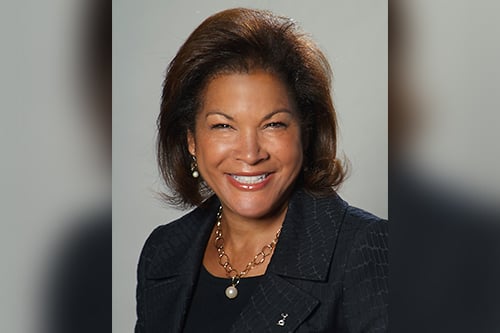

Susan Johnson’s name is widely recognized in insurance thanks to her work in promoting diversity and inclusion from her post as the chief D&I officer at The Hart-ford, which has been recognized as one of the most inclusive companies in insurance. But before Johnson helped The Hartford become an industry leader in D&I, she cut her teeth developing and leading pioneering HR programs in both the public sector and at Fortune 500 companies.
After graduating from Cornell University’s School of Industrial and Labor Relations, Johnson began what she calls a typical career path for HR professionals. One of her earliest positions was as manager of leadership development at e-commerce company Pitney Bowes, where she returned later in her career after a stint as chief of staff for the deputy secretary of the Department of Health and Human Services.
“What really defined my career was that at each company, I was engaged in diversity and inclusion work early on,” Johnson says.
While at Pitney Bowes, for example, she and her team developed precursors to employee resource groups focused on minorities and women, and Johnson had a chance to chair the minority group. At that point in the late 1990s and early 2000s, D&I was still in its infancy, and companies were realizing that, based on demographic projections, a significant number of new applicants would be women and people of color, Johnson explains. In turn, many firms, including Pitney Bowes, were trying to figure out what this meant for their organizations, giving Johnson a seat at the table in developing D&I-focused HR programs, which would set the tone for the rest of her career.
Making waves in insurance
By 2013, Johnson was ready to bring the lessons she’d learned about D&I to another sector. She was drawn to a role at The Hart-ford, where she would have the opportunity to lead diversity and inclusion alongside a supportive leadership team. “It was a highly ethical company with a strong character and a good reputation,” she says.
Because The Hartford had recently decided to rethink its D&I strategy, the role offered Johnson the chance to have a say in what D&I would look like at the company for years to come. For the past seven years, she’s done just that, helping The Hartford develop and implement an effective D&I strategy that has seen three iterations.
The first phase focused on building a foundation for success by establishing a common language to discuss D&I, as well as under-standing what diversity and inclusion means and the behaviors required to achieve it. The second cycle of the D&I strategy took these foundational skills to the next level.
“It was a much more complex world, both internally and externally, and we needed to enable our organization to be able to talk about stressors and differences in the workplace,” Johnson says.
During this cycle, The Hartford launched its Courageous Conversations initiative and has since held hundreds of conversations with thousands of employees on tough topics such as race, age, gender, sexual orientation and ageism.
In the third iteration of the D&I strategy, Johnson and her team honed in on account-ability and inclusiveness, which has been empowered by the harder, more aggressive work that still needs to be done to address racial equality. Johnson’s team has also examined talent initiatives to increase workforce representation for women and people of color, as well as to better understand other communities (including people with disabilities, women of color and the transgender community) to ensure that The Hartford is known as a company that welcomes everyone.
A critical moment in time
The next phase of The Hartford’s D&I strategy comes at a critical point in history, when the modern civil rights movement has been reignited by the death of George Floyd at the hands of police in Minneapolis, which set off a wave of Black Lives Matter protests in the US and around the world.
“Nobody can deny the significance of the racial reckoning that we’ve experienced over the past three months,” Johnson says. “What’s gratifying for me is that the work we’ve been doing at The Hartford for the past seven years has enabled us to have a solid foundation to hear, address and appreciate the heightened level of this conversation. We weren’t starting from scratch following George Floyd’s murder and the heightened calls for racial equality. We had strong initiatives, culture and skill sets in place for our employees and leaders to talk about what was happening, how it hit them, what personal learnings they had and what sort of behavioral commitments they could make.”
As Johnson looks at the broader insurance industry, she is encouraged by the progress made on D&I since she joined The Hartford. At the outset, she was surprised by the lack of formal diversity and inclusion initiatives in insurance, but today, she sees many indicators that the industry is working hard to implement such strategies. From the National African American Insurance Association, where Johnson is secretary of the board, to organizations like Dive In and trade groups that are taking a harder look at diversity, there’s been a significant uptick in D&I-related work from just five or six years ago.
“The exponential growth of activity within the industry is encouraging, and our opportunity right now is to sustain it and see some real results,” Johnson says. “We’re all going to be pitching in very aggressively to make sure we translate all of this action and initiative into results that culminate in greater representation, specifically of people of color within the insurance industry, but also more organizations having a deeper and more strategically thought-out approach and definition of diversity and inclusion that makes sense for their organization.”
